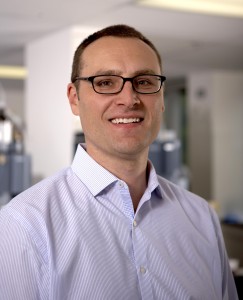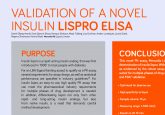Interview with Mark Wrona (Waters Corporation) on LC-MS technologies

 Mark Wrona received his B.Sc. (Hons) in Biochemistry/Biotechnology at the University of Waterloo (Canada) and his M.Sc. in Biochemistry at the University of Western Ontario (Canada). After university, he joined the Merck Frosst Medicinal Chemistry department in Montreal in 2004 to support compound lead optimization as well as to manage open access chemistry and bioanalysis facilities. From here he made a jump to the Global Department of Drug Metabolism at Merck and took a more active role in developing high resolution mass spectrometry as a powerful and routine tool for screening, characterizing and quantifying metabolites.
Mark Wrona received his B.Sc. (Hons) in Biochemistry/Biotechnology at the University of Waterloo (Canada) and his M.Sc. in Biochemistry at the University of Western Ontario (Canada). After university, he joined the Merck Frosst Medicinal Chemistry department in Montreal in 2004 to support compound lead optimization as well as to manage open access chemistry and bioanalysis facilities. From here he made a jump to the Global Department of Drug Metabolism at Merck and took a more active role in developing high resolution mass spectrometry as a powerful and routine tool for screening, characterizing and quantifying metabolites.
In 2010, Mark joined the Pharmaceutical & Life Sciences Group at Waters Corporation (MA; USA) and continues to seek and develop solutions for drug development. His primary interest is the development and practical use of LC-MS technologies and informatics for the identification, characterization and quantitation of metabolic and degradation pathways for small molecules and biotherapeutics. He currently manages a team of 8 scientists based in the US and UK developing and marketing pharmaceutical applications and solutions for discovery and development. The team studies and develops applications in a wide variety of areas including Bioanalysis, Drug Metabolism, Pharmaceutical Development, Quality Control, Method Development for small molecules, biotherapeutics as well as natural products.
Could you tell us a little about your career to date and how you ended up in your current role?
I originally started out on the synthetic chemistry side working on small molecules and then later synthesis of cyclic and hybridized peptide molecules. My graduate supervisor Gilles Lajoie was an organic chemist who started up a core mass spectrometry facility for the characterization of peptides and later proteins, so I had a lot of early exposure to high end mass spectrometry as well as capillary LC technologies. I then joined Merck Frosst in Montreal in 2004 under Kevin Bateman and Debbie Nicoll-Griffith in the DMPK department, which was at the time rapidly updating and upgrading its LC-MS capabilities. In this time, I worked on various drug programs with tandem quadrupoles, traps and a number of Quadrupole TOF instruments doing quantitative work and progressively more and more characterization and profiling. In 2010, I decided to join Waters as part of the metabolic profiling team that focussed primarily on HRMS technologies for screening, profiling and imaging. A few years ago I started managing a small team of scientists focussed on DMPK applications. This team has progressively grown and I now manage a larger applications team split between the UK and US, which focusses on most areas of pharma, discovery, and natural products research all the way through development.
Do you believe the use of low flow LC (micro flow and nano flow) will continue to increase?
Yes, I think there is a really long term trend here. We are dealing with more complex problems and matrices, and at the same time we are targeting lower concentrations of conventional small molecule drugs. We are also working with proteins or protein-based drugs which can be very low concentration, very heterogeneous and also very analytically challenging. As these reagents are also incredibly expensive and in some cases highly toxic, learning to work with smaller amounts is very important. I think laboratories are starting to look for smaller platforms with more sophisticated integration, using less solvent and creating less waste. I think the most important thing is ease of use, and making this type of technology accessible and reproducible. With tile base low flow technologies such as ionKey, we have a lot of future capabilities to scale down analytical methods, build innovative assays and also explore diagnostics which are easily transportable from laboratory to laboratory.
What new technology/instrumentation do you believe has had the biggest impact during your time working with LC-MS for the identification, characterization and quantitation of metabolic and degradation pathways?
There are actually two things; one is that the LC-MS hardware just gets better, faster and more sensitive. However the biggest change in science generally is probably the use of informatics. How we build technologies to not only analyze samples, but derive and cross correlate meaningful information from the analysis of 1000s of patients and samples is getting more and more important as we target more complex diseases.
What are the challenges faced when using LC-MS technologies in the identification of metabolites?
We always say everything is compound dependent and it’s true – every time you get a new molecule to analyse you have to use many different instruments. Humans and animals have evolved many different mechanisms to metabolize drugs and it’s hard to predict the precise pathways ahead of time. You may be trying to solve separations problems as well. Finally, molecules are getting more complex all the time, especially within the area of drug development where complex biotherapeutics such as ADCs are common place in DMPK departments.
How can enantiomers of active metabolites be separated?
The best technologies we have at the moment are supercritical fluidic chromatography (SFC) for separations, systems like our UPC2 for analytical separations, or Prep SFC systems for larger scale separations. The Chemistry Group also has quite an active program putting out new chiral column technologies such as the Trefoil line. These technologies have a significant impact on understanding and isolating molecules, and also improving chemical manufacturing processes in pharmaceutical companies and in the natural product space.
You employ LC-MS in the identification of biotherapeutics; do you see LC-MS as a complimentary method to LBAs for biotherapeutic identification?
Yes, absolutely – I think LC-MS is actually a great complementary technology to many existing gold standard technologies. LBAs are very sensitive and amenable to high throughput screening and generally have very defined end points. On the other hand, LC-MS is able to develop assays very rapidly and you also have an element of teasing apart and interrogating the results. LBAs can vary in selectivity and cross selectivity, while LC-MS can help you assess heterogeneity and specificity of therapeutics and targets by direct interpretation of the data.
What are you looking forward to working on over the coming year?
I think that we’re going to continue to drive detection limits down even further for all of our technologies. What I always look forward to is working with as many collaborators as I can with my team, to see how far we can push our technologies in the real world. Then, to take this information and work with the developments, engineers and scientists at Waters to help develop the next generation of technology you’ll get to see in the next few years.





